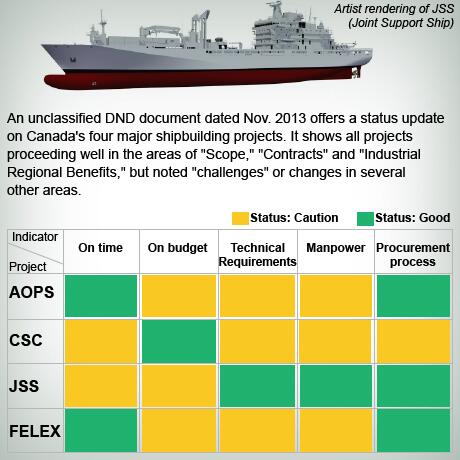from: CBC News
Shipbuilding memo shows more delays, cost overruns
With Canada's only Pacific supply ship laid up in Hawaii, help doesn't appear to be close
By Terry Milewski, CBC News
An internal government memo obtained by CBC News shows that all four parts of the government's huge shipbuilding program are either over budget, behind schedule, or both.
Written Oct. 7 last year by the deputy minister of national defence, Richard Fadden, the memo shows that three of those four programs also face "major challenges" of a technical nature, as well as difficulties lining up skilled manpower to get the ships built at all.
The memo, released to the CBC following an Access to Information request, leaves little doubt that Canada's crippled supply ship, HMCS Protecteur, won't be replaced before the year 2020.
The spectacle of the 46-year-old Protecteur, Canada's only supply ship in the Pacific, being towed into Honolulu after an engine-room fire has thrown the lack of a replacement into sharp focus.
Although there's a plan to build two new supply ships, there's no sign the work will even begin until late 2016. That means a new one won't enter service until the end of the decade.
The Fadden memo was intended to assure Defence Minister Rob Nicholson that there are "many success stories" in the procurement saga that has dogged the government for years.
But the attached details show no major program without problems.
A chart summarizing the state of the shipbuilding effort uses green and yellow squares to indicate where those problems are — the green meaning, on track, and yellow meaning, trouble — and there's a lot of yellow.
For the Joint Support Ships — that's the pair of supply ships — the chart shows trouble with both the schedule and the price. The memo explains that this means the program is up to 20 per cent behind schedule and up to 10 per cent over budget.
For the Arctic Patrol Ships, the chart shows yellow for three measures: the cost, "HR" — meaning Human Resources, or skilled workers — and technical issues. The memo describes these as "major challenges in finding solutions; significant scope changes may be required." That suggests the ships may need to be redesigned in order to fix the technical problems.
All of those same issues —
cost, manpower and technical — also dog the plan to upgrade Canada's Halifax-class frigates.
But for the biggest program of all — the $38-billion project to build 15 new warships known as "Surface Combatants" — there is trouble cited on four measures: the schedule, the technical and manpower issues and the procurement strategy itself. It doesn't say how any of those can be fixed, but it does say they are fixable.
(...EDITED)- more at link




